Court Observation Report: Analyzing Procedural Fairness in Courts
VerifiedAdded on 2023/06/08
|9
|1812
|380
Report
AI Summary
This courtroom observation report analyzes judicial conduct, focusing on neutrality, respect, and voice within the Australian legal system. The report details a court visit, assessing the judge's ability to maintain impartiality, treat all parties with respect, and provide participants with a fair opportunity to voice their perspectives. It evaluates whether the judge's actions align with principles of procedural fairness, which are crucial for building community trust in legal authorities and ensuring equitable treatment for all individuals. The report concludes with a personal reflection on whether the observer would feel confident in receiving fair treatment from the judge, based on the observed conduct and adherence to legal principles.
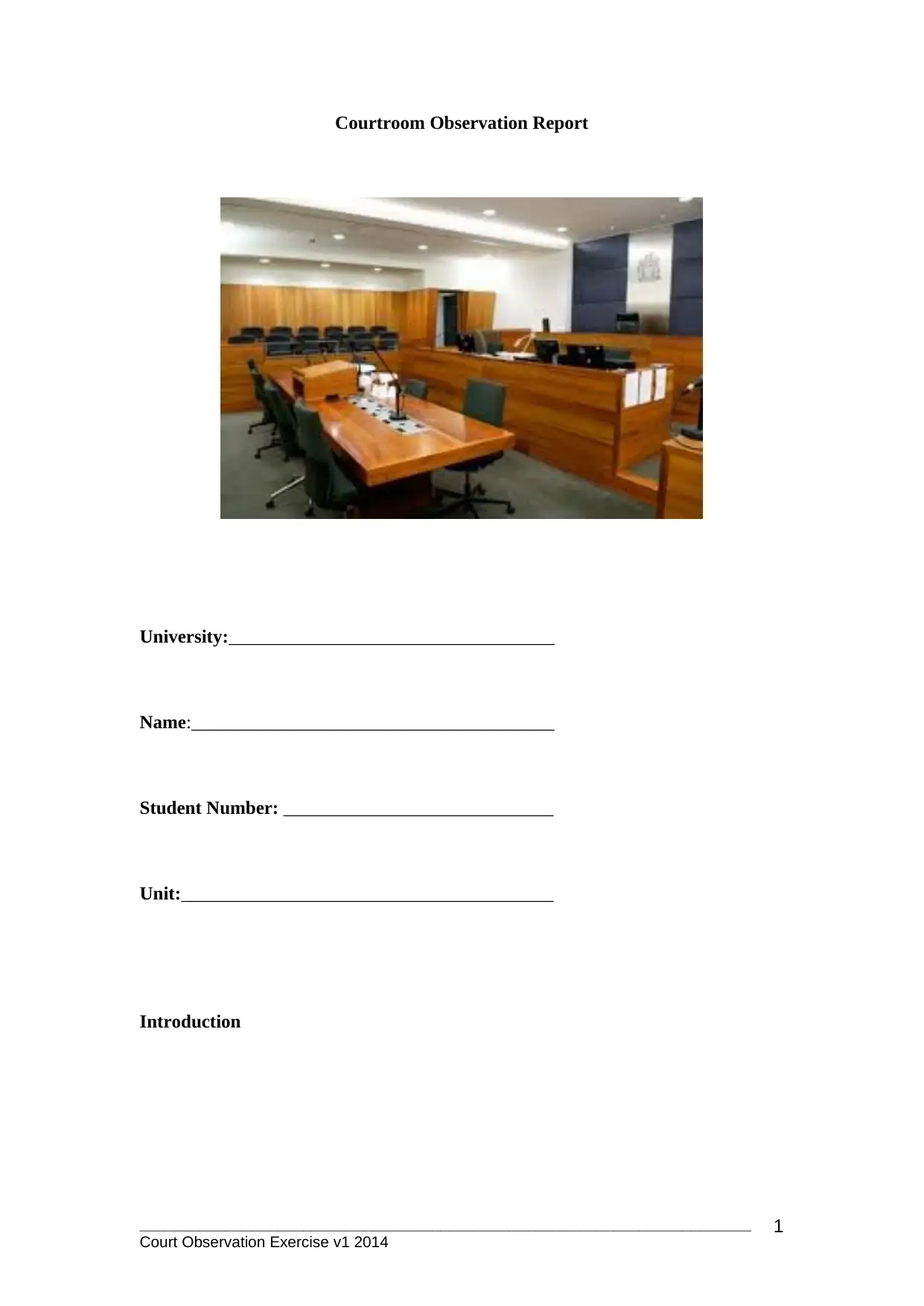
Courtroom Observation Report
University:___________________________________
Name:_______________________________________
Student Number: _____________________________
Unit:________________________________________
Introduction
_______________________________________________________________________
Court Observation Exercise v1 2014 1
University:___________________________________
Name:_______________________________________
Student Number: _____________________________
Unit:________________________________________
Introduction
_______________________________________________________________________
Court Observation Exercise v1 2014 1
Paraphrase This Document
Need a fresh take? Get an instant paraphrase of this document with our AI Paraphraser
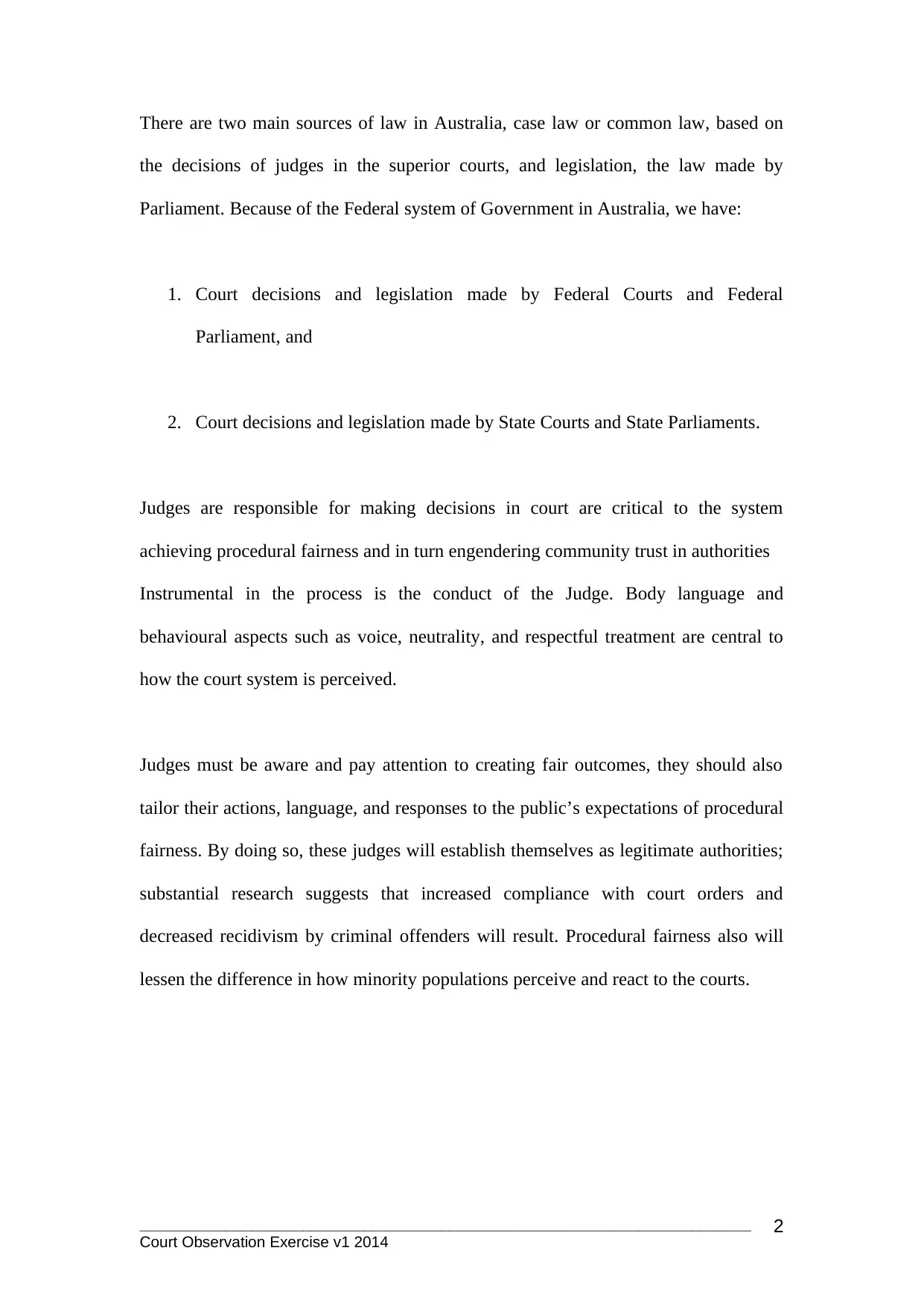
There are two main sources of law in Australia, case law or common law, based on
the decisions of judges in the superior courts, and legislation, the law made by
Parliament. Because of the Federal system of Government in Australia, we have:
1. Court decisions and legislation made by Federal Courts and Federal
Parliament, and
2. Court decisions and legislation made by State Courts and State Parliaments.
Judges are responsible for making decisions in court are critical to the system
achieving procedural fairness and in turn engendering community trust in authorities
Instrumental in the process is the conduct of the Judge. Body language and
behavioural aspects such as voice, neutrality, and respectful treatment are central to
how the court system is perceived.
Judges must be aware and pay attention to creating fair outcomes, they should also
tailor their actions, language, and responses to the public’s expectations of procedural
fairness. By doing so, these judges will establish themselves as legitimate authorities;
substantial research suggests that increased compliance with court orders and
decreased recidivism by criminal offenders will result. Procedural fairness also will
lessen the difference in how minority populations perceive and react to the courts.
_______________________________________________________________________
Court Observation Exercise v1 2014 2
the decisions of judges in the superior courts, and legislation, the law made by
Parliament. Because of the Federal system of Government in Australia, we have:
1. Court decisions and legislation made by Federal Courts and Federal
Parliament, and
2. Court decisions and legislation made by State Courts and State Parliaments.
Judges are responsible for making decisions in court are critical to the system
achieving procedural fairness and in turn engendering community trust in authorities
Instrumental in the process is the conduct of the Judge. Body language and
behavioural aspects such as voice, neutrality, and respectful treatment are central to
how the court system is perceived.
Judges must be aware and pay attention to creating fair outcomes, they should also
tailor their actions, language, and responses to the public’s expectations of procedural
fairness. By doing so, these judges will establish themselves as legitimate authorities;
substantial research suggests that increased compliance with court orders and
decreased recidivism by criminal offenders will result. Procedural fairness also will
lessen the difference in how minority populations perceive and react to the courts.
_______________________________________________________________________
Court Observation Exercise v1 2014 2
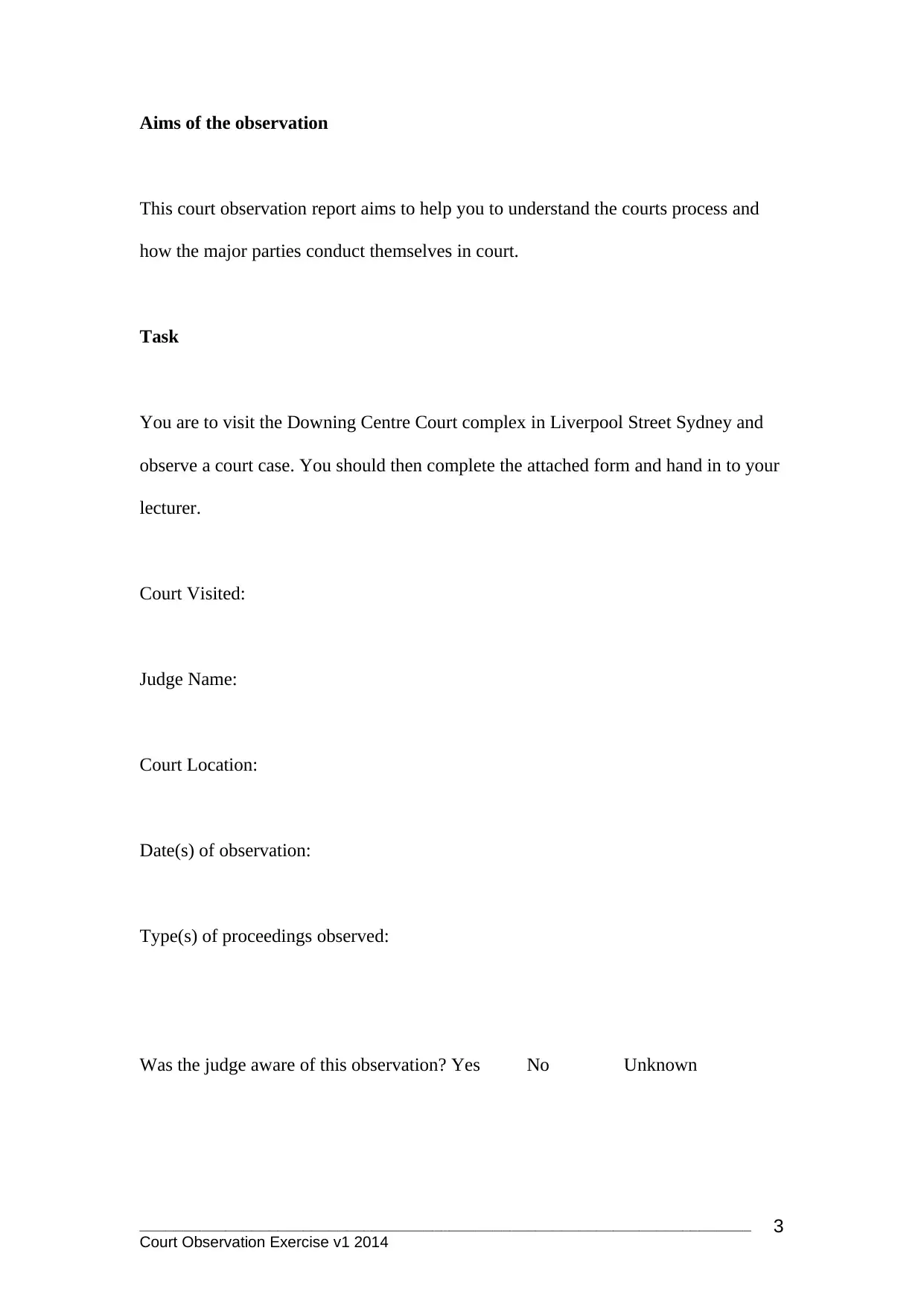
Aims of the observation
This court observation report aims to help you to understand the courts process and
how the major parties conduct themselves in court.
Task
You are to visit the Downing Centre Court complex in Liverpool Street Sydney and
observe a court case. You should then complete the attached form and hand in to your
lecturer.
Court Visited:
Judge Name:
Court Location:
Date(s) of observation:
Type(s) of proceedings observed:
Was the judge aware of this observation? Yes No Unknown
_______________________________________________________________________
Court Observation Exercise v1 2014 3
This court observation report aims to help you to understand the courts process and
how the major parties conduct themselves in court.
Task
You are to visit the Downing Centre Court complex in Liverpool Street Sydney and
observe a court case. You should then complete the attached form and hand in to your
lecturer.
Court Visited:
Judge Name:
Court Location:
Date(s) of observation:
Type(s) of proceedings observed:
Was the judge aware of this observation? Yes No Unknown
_______________________________________________________________________
Court Observation Exercise v1 2014 3
⊘ This is a preview!⊘
Do you want full access?
Subscribe today to unlock all pages.

Trusted by 1+ million students worldwide
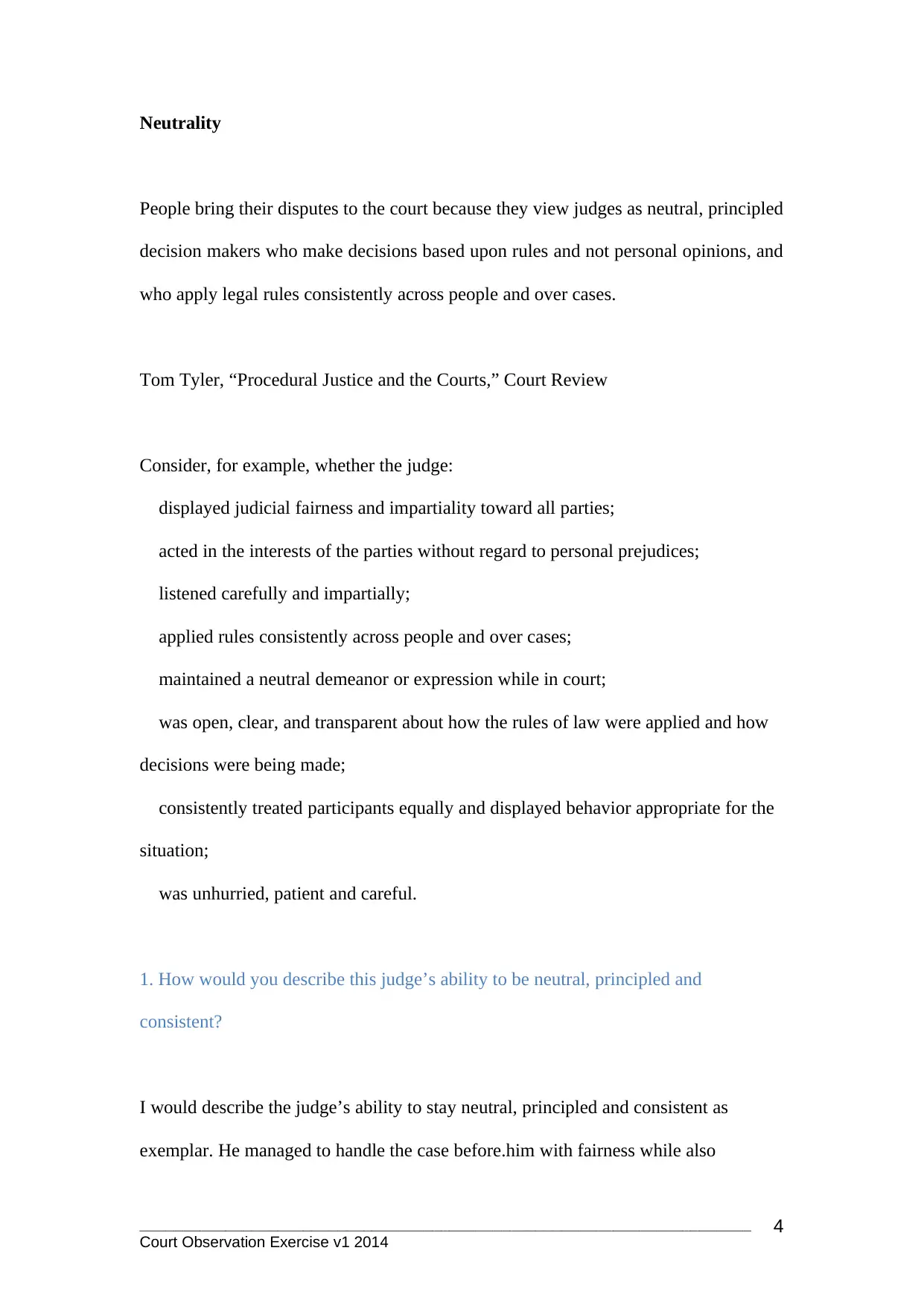
Neutrality
People bring their disputes to the court because they view judges as neutral, principled
decision makers who make decisions based upon rules and not personal opinions, and
who apply legal rules consistently across people and over cases.
Tom Tyler, “Procedural Justice and the Courts,” Court Review
Consider, for example, whether the judge:
displayed judicial fairness and impartiality toward all parties;
acted in the interests of the parties without regard to personal prejudices;
listened carefully and impartially;
applied rules consistently across people and over cases;
maintained a neutral demeanor or expression while in court;
was open, clear, and transparent about how the rules of law were applied and how
decisions were being made;
consistently treated participants equally and displayed behavior appropriate for the
situation;
was unhurried, patient and careful.
1. How would you describe this judge’s ability to be neutral, principled and
consistent?
I would describe the judge’s ability to stay neutral, principled and consistent as
exemplar. He managed to handle the case before.him with fairness while also
_______________________________________________________________________
Court Observation Exercise v1 2014 4
People bring their disputes to the court because they view judges as neutral, principled
decision makers who make decisions based upon rules and not personal opinions, and
who apply legal rules consistently across people and over cases.
Tom Tyler, “Procedural Justice and the Courts,” Court Review
Consider, for example, whether the judge:
displayed judicial fairness and impartiality toward all parties;
acted in the interests of the parties without regard to personal prejudices;
listened carefully and impartially;
applied rules consistently across people and over cases;
maintained a neutral demeanor or expression while in court;
was open, clear, and transparent about how the rules of law were applied and how
decisions were being made;
consistently treated participants equally and displayed behavior appropriate for the
situation;
was unhurried, patient and careful.
1. How would you describe this judge’s ability to be neutral, principled and
consistent?
I would describe the judge’s ability to stay neutral, principled and consistent as
exemplar. He managed to handle the case before.him with fairness while also
_______________________________________________________________________
Court Observation Exercise v1 2014 4
Paraphrase This Document
Need a fresh take? Get an instant paraphrase of this document with our AI Paraphraser
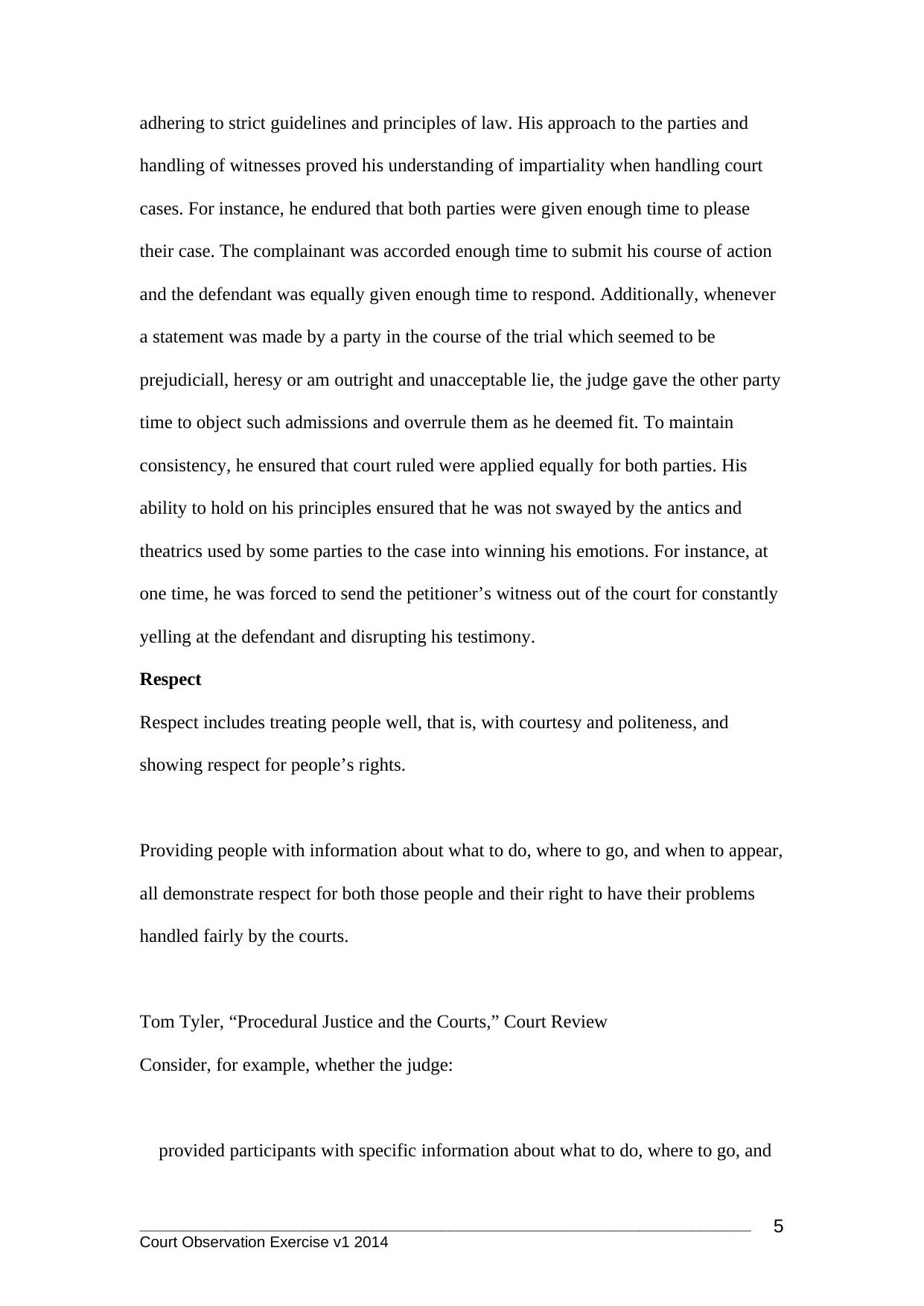
adhering to strict guidelines and principles of law. His approach to the parties and
handling of witnesses proved his understanding of impartiality when handling court
cases. For instance, he endured that both parties were given enough time to please
their case. The complainant was accorded enough time to submit his course of action
and the defendant was equally given enough time to respond. Additionally, whenever
a statement was made by a party in the course of the trial which seemed to be
prejudiciall, heresy or am outright and unacceptable lie, the judge gave the other party
time to object such admissions and overrule them as he deemed fit. To maintain
consistency, he ensured that court ruled were applied equally for both parties. His
ability to hold on his principles ensured that he was not swayed by the antics and
theatrics used by some parties to the case into winning his emotions. For instance, at
one time, he was forced to send the petitioner’s witness out of the court for constantly
yelling at the defendant and disrupting his testimony.
Respect
Respect includes treating people well, that is, with courtesy and politeness, and
showing respect for people’s rights.
Providing people with information about what to do, where to go, and when to appear,
all demonstrate respect for both those people and their right to have their problems
handled fairly by the courts.
Tom Tyler, “Procedural Justice and the Courts,” Court Review
Consider, for example, whether the judge:
provided participants with specific information about what to do, where to go, and
_______________________________________________________________________
Court Observation Exercise v1 2014 5
handling of witnesses proved his understanding of impartiality when handling court
cases. For instance, he endured that both parties were given enough time to please
their case. The complainant was accorded enough time to submit his course of action
and the defendant was equally given enough time to respond. Additionally, whenever
a statement was made by a party in the course of the trial which seemed to be
prejudiciall, heresy or am outright and unacceptable lie, the judge gave the other party
time to object such admissions and overrule them as he deemed fit. To maintain
consistency, he ensured that court ruled were applied equally for both parties. His
ability to hold on his principles ensured that he was not swayed by the antics and
theatrics used by some parties to the case into winning his emotions. For instance, at
one time, he was forced to send the petitioner’s witness out of the court for constantly
yelling at the defendant and disrupting his testimony.
Respect
Respect includes treating people well, that is, with courtesy and politeness, and
showing respect for people’s rights.
Providing people with information about what to do, where to go, and when to appear,
all demonstrate respect for both those people and their right to have their problems
handled fairly by the courts.
Tom Tyler, “Procedural Justice and the Courts,” Court Review
Consider, for example, whether the judge:
provided participants with specific information about what to do, where to go, and
_______________________________________________________________________
Court Observation Exercise v1 2014 5
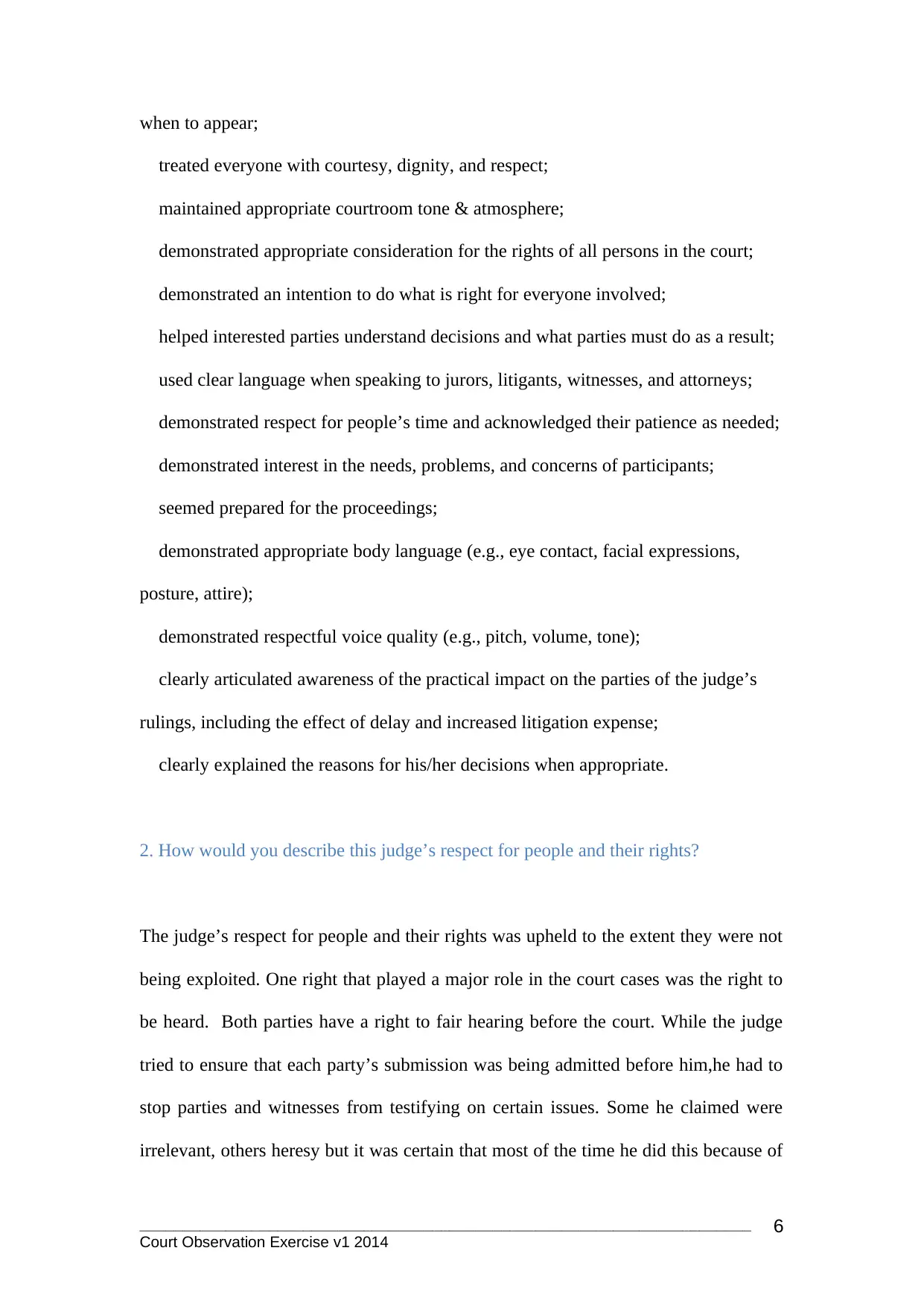
when to appear;
treated everyone with courtesy, dignity, and respect;
maintained appropriate courtroom tone & atmosphere;
demonstrated appropriate consideration for the rights of all persons in the court;
demonstrated an intention to do what is right for everyone involved;
helped interested parties understand decisions and what parties must do as a result;
used clear language when speaking to jurors, litigants, witnesses, and attorneys;
demonstrated respect for people’s time and acknowledged their patience as needed;
demonstrated interest in the needs, problems, and concerns of participants;
seemed prepared for the proceedings;
demonstrated appropriate body language (e.g., eye contact, facial expressions,
posture, attire);
demonstrated respectful voice quality (e.g., pitch, volume, tone);
clearly articulated awareness of the practical impact on the parties of the judge’s
rulings, including the effect of delay and increased litigation expense;
clearly explained the reasons for his/her decisions when appropriate.
2. How would you describe this judge’s respect for people and their rights?
The judge’s respect for people and their rights was upheld to the extent they were not
being exploited. One right that played a major role in the court cases was the right to
be heard. Both parties have a right to fair hearing before the court. While the judge
tried to ensure that each party’s submission was being admitted before him,he had to
stop parties and witnesses from testifying on certain issues. Some he claimed were
irrelevant, others heresy but it was certain that most of the time he did this because of
_______________________________________________________________________
Court Observation Exercise v1 2014 6
treated everyone with courtesy, dignity, and respect;
maintained appropriate courtroom tone & atmosphere;
demonstrated appropriate consideration for the rights of all persons in the court;
demonstrated an intention to do what is right for everyone involved;
helped interested parties understand decisions and what parties must do as a result;
used clear language when speaking to jurors, litigants, witnesses, and attorneys;
demonstrated respect for people’s time and acknowledged their patience as needed;
demonstrated interest in the needs, problems, and concerns of participants;
seemed prepared for the proceedings;
demonstrated appropriate body language (e.g., eye contact, facial expressions,
posture, attire);
demonstrated respectful voice quality (e.g., pitch, volume, tone);
clearly articulated awareness of the practical impact on the parties of the judge’s
rulings, including the effect of delay and increased litigation expense;
clearly explained the reasons for his/her decisions when appropriate.
2. How would you describe this judge’s respect for people and their rights?
The judge’s respect for people and their rights was upheld to the extent they were not
being exploited. One right that played a major role in the court cases was the right to
be heard. Both parties have a right to fair hearing before the court. While the judge
tried to ensure that each party’s submission was being admitted before him,he had to
stop parties and witnesses from testifying on certain issues. Some he claimed were
irrelevant, others heresy but it was certain that most of the time he did this because of
_______________________________________________________________________
Court Observation Exercise v1 2014 6
⊘ This is a preview!⊘
Do you want full access?
Subscribe today to unlock all pages.

Trusted by 1+ million students worldwide
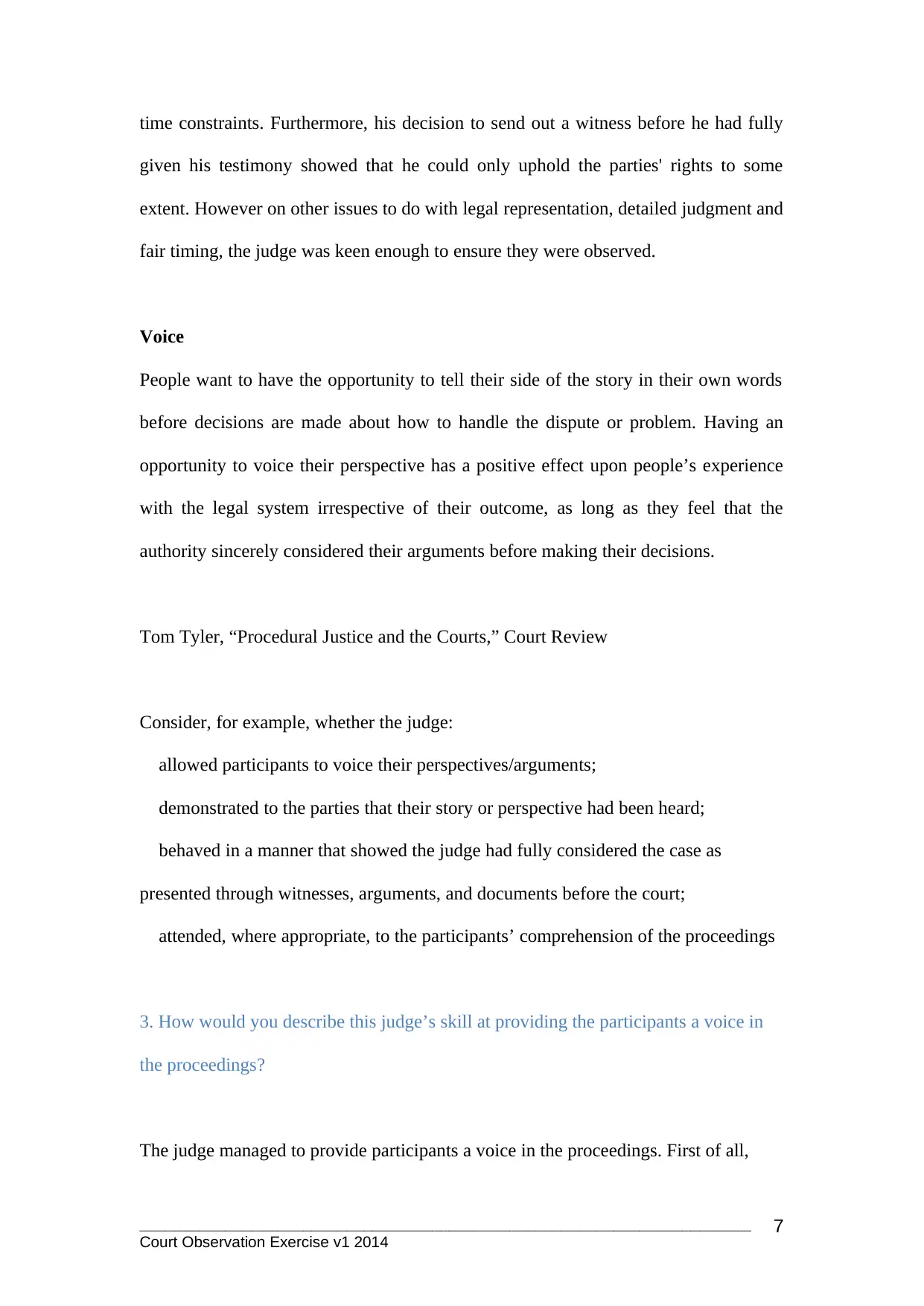
time constraints. Furthermore, his decision to send out a witness before he had fully
given his testimony showed that he could only uphold the parties' rights to some
extent. However on other issues to do with legal representation, detailed judgment and
fair timing, the judge was keen enough to ensure they were observed.
Voice
People want to have the opportunity to tell their side of the story in their own words
before decisions are made about how to handle the dispute or problem. Having an
opportunity to voice their perspective has a positive effect upon people’s experience
with the legal system irrespective of their outcome, as long as they feel that the
authority sincerely considered their arguments before making their decisions.
Tom Tyler, “Procedural Justice and the Courts,” Court Review
Consider, for example, whether the judge:
allowed participants to voice their perspectives/arguments;
demonstrated to the parties that their story or perspective had been heard;
behaved in a manner that showed the judge had fully considered the case as
presented through witnesses, arguments, and documents before the court;
attended, where appropriate, to the participants’ comprehension of the proceedings
3. How would you describe this judge’s skill at providing the participants a voice in
the proceedings?
The judge managed to provide participants a voice in the proceedings. First of all,
_______________________________________________________________________
Court Observation Exercise v1 2014 7
given his testimony showed that he could only uphold the parties' rights to some
extent. However on other issues to do with legal representation, detailed judgment and
fair timing, the judge was keen enough to ensure they were observed.
Voice
People want to have the opportunity to tell their side of the story in their own words
before decisions are made about how to handle the dispute or problem. Having an
opportunity to voice their perspective has a positive effect upon people’s experience
with the legal system irrespective of their outcome, as long as they feel that the
authority sincerely considered their arguments before making their decisions.
Tom Tyler, “Procedural Justice and the Courts,” Court Review
Consider, for example, whether the judge:
allowed participants to voice their perspectives/arguments;
demonstrated to the parties that their story or perspective had been heard;
behaved in a manner that showed the judge had fully considered the case as
presented through witnesses, arguments, and documents before the court;
attended, where appropriate, to the participants’ comprehension of the proceedings
3. How would you describe this judge’s skill at providing the participants a voice in
the proceedings?
The judge managed to provide participants a voice in the proceedings. First of all,
_______________________________________________________________________
Court Observation Exercise v1 2014 7
Paraphrase This Document
Need a fresh take? Get an instant paraphrase of this document with our AI Paraphraser
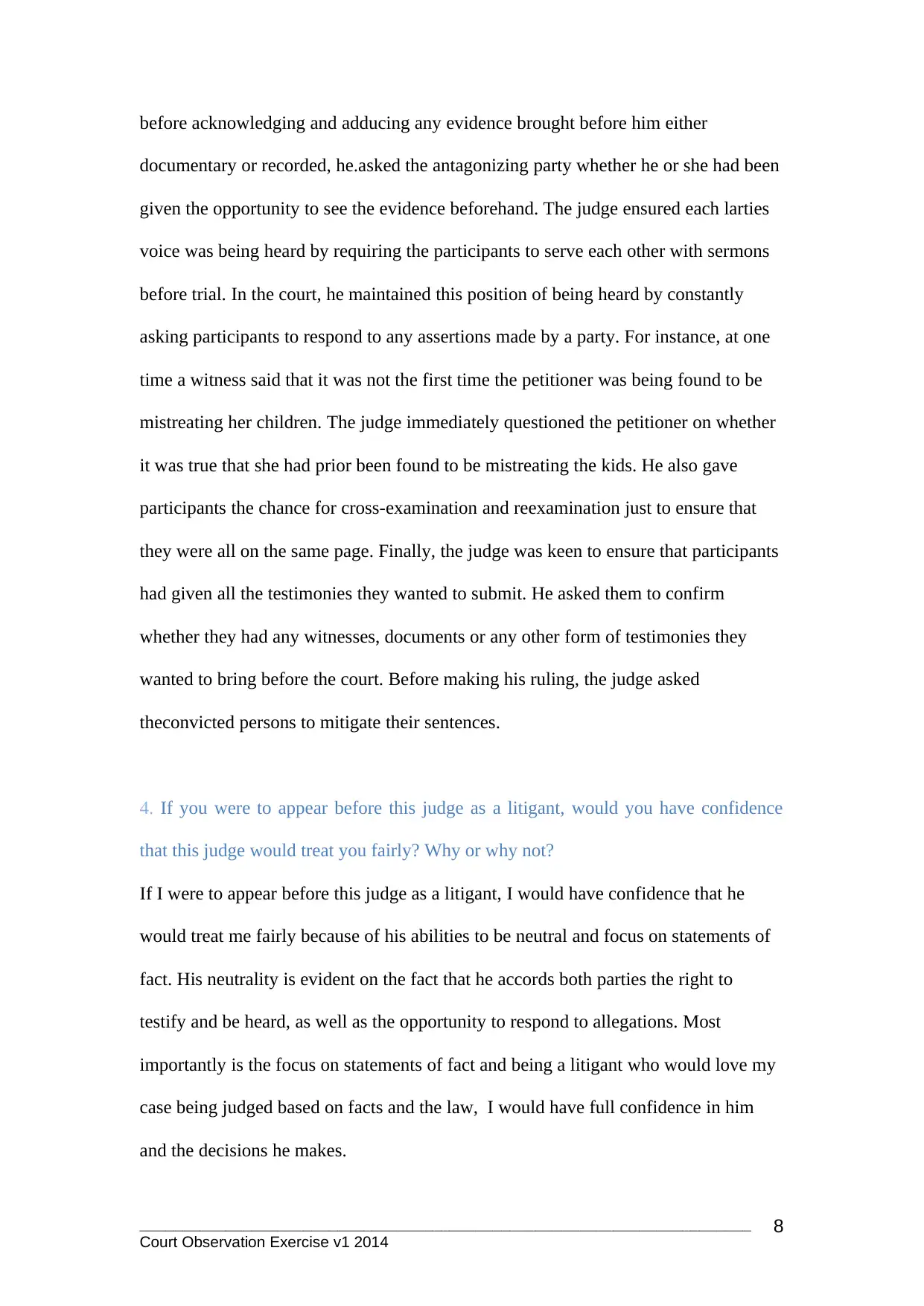
before acknowledging and adducing any evidence brought before him either
documentary or recorded, he.asked the antagonizing party whether he or she had been
given the opportunity to see the evidence beforehand. The judge ensured each larties
voice was being heard by requiring the participants to serve each other with sermons
before trial. In the court, he maintained this position of being heard by constantly
asking participants to respond to any assertions made by a party. For instance, at one
time a witness said that it was not the first time the petitioner was being found to be
mistreating her children. The judge immediately questioned the petitioner on whether
it was true that she had prior been found to be mistreating the kids. He also gave
participants the chance for cross-examination and reexamination just to ensure that
they were all on the same page. Finally, the judge was keen to ensure that participants
had given all the testimonies they wanted to submit. He asked them to confirm
whether they had any witnesses, documents or any other form of testimonies they
wanted to bring before the court. Before making his ruling, the judge asked
theconvicted persons to mitigate their sentences.
4. If you were to appear before this judge as a litigant, would you have confidence
that this judge would treat you fairly? Why or why not?
If I were to appear before this judge as a litigant, I would have confidence that he
would treat me fairly because of his abilities to be neutral and focus on statements of
fact. His neutrality is evident on the fact that he accords both parties the right to
testify and be heard, as well as the opportunity to respond to allegations. Most
importantly is the focus on statements of fact and being a litigant who would love my
case being judged based on facts and the law, I would have full confidence in him
and the decisions he makes.
_______________________________________________________________________
Court Observation Exercise v1 2014 8
documentary or recorded, he.asked the antagonizing party whether he or she had been
given the opportunity to see the evidence beforehand. The judge ensured each larties
voice was being heard by requiring the participants to serve each other with sermons
before trial. In the court, he maintained this position of being heard by constantly
asking participants to respond to any assertions made by a party. For instance, at one
time a witness said that it was not the first time the petitioner was being found to be
mistreating her children. The judge immediately questioned the petitioner on whether
it was true that she had prior been found to be mistreating the kids. He also gave
participants the chance for cross-examination and reexamination just to ensure that
they were all on the same page. Finally, the judge was keen to ensure that participants
had given all the testimonies they wanted to submit. He asked them to confirm
whether they had any witnesses, documents or any other form of testimonies they
wanted to bring before the court. Before making his ruling, the judge asked
theconvicted persons to mitigate their sentences.
4. If you were to appear before this judge as a litigant, would you have confidence
that this judge would treat you fairly? Why or why not?
If I were to appear before this judge as a litigant, I would have confidence that he
would treat me fairly because of his abilities to be neutral and focus on statements of
fact. His neutrality is evident on the fact that he accords both parties the right to
testify and be heard, as well as the opportunity to respond to allegations. Most
importantly is the focus on statements of fact and being a litigant who would love my
case being judged based on facts and the law, I would have full confidence in him
and the decisions he makes.
_______________________________________________________________________
Court Observation Exercise v1 2014 8

_______________________________________________________________________
Court Observation Exercise v1 2014 9
Court Observation Exercise v1 2014 9
⊘ This is a preview!⊘
Do you want full access?
Subscribe today to unlock all pages.

Trusted by 1+ million students worldwide
1 out of 9
Related Documents
Your All-in-One AI-Powered Toolkit for Academic Success.
+13062052269
info@desklib.com
Available 24*7 on WhatsApp / Email
![[object Object]](/_next/static/media/star-bottom.7253800d.svg)
Unlock your academic potential
Copyright © 2020–2025 A2Z Services. All Rights Reserved. Developed and managed by ZUCOL.


![Business Law Courtroom Observation Report - [University Name]](/_next/image/?url=https%3A%2F%2Fdesklib.com%2Fmedia%2Fimages%2Fat%2F18a9b662a0f841928b726145cc156ea0.jpg&w=256&q=75)